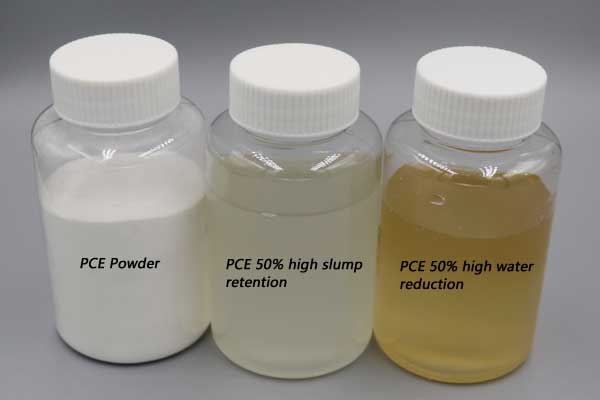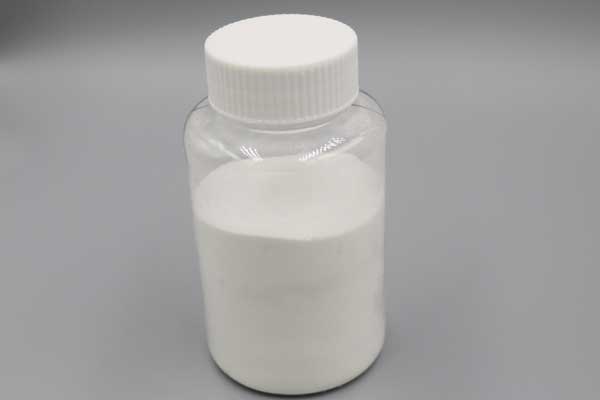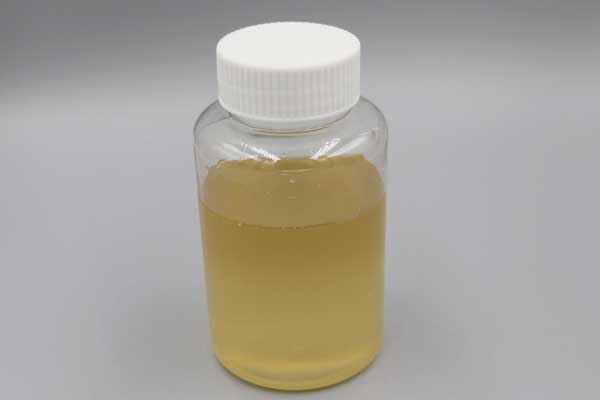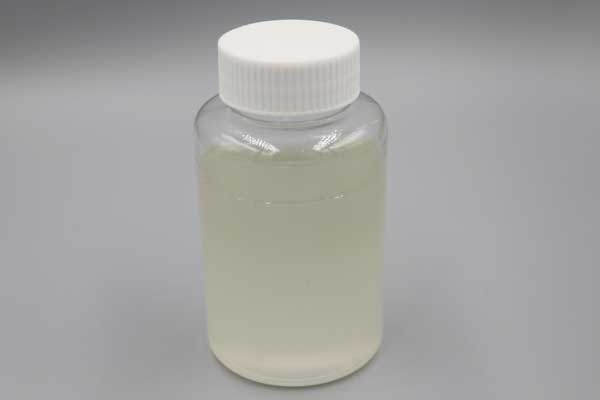Home » Polycarboxylate Superplasticizer

Polycarboxylate Superplasticizer Powder & Liquid
- CAS NO.: 27599-56-0
- HS Code: 38244010
- Appearance: Solid & Liquid
- Water reducing rate: ≥25%
- Package: PCE liquid is 230kg PE drum, 1100kg IBC tank or flexitank. PCE Powder, 25 kg PP woven bag.
- Excellent performance: Polycarboxylate based superplasticizer is currently a high-efficiency water reducing agent with the highest scientific and technological content, the best application prospects, and the best comprehensive performance. PCE chemical is also a series of water reducing agents with excellent performance that integrates water reduction, slump retention, reinforcement, anti-shrinkage and environmental protection. It can completely solve the weakness of high-strength, high-performance concrete with the performance of high viscosity and poor construction performance.



Polycarboxylate Superplasticizer Specification
| Items | Standard | |||
| PCE(High Water Reduction) | PCE(High Slump Retention ) | PCE-Powder | ||
| Appearance | Light Yellow Liquid | Clear Transparent Liquid | White Powder | |
| Solid Content, % | 50±1.0 | 50±1.0 | 98±1.0 | |
| Density (23℃) (kg/m3) | 1.13±0.02 | 1.05-1.10 | 600±50 | |
| PH | 6.5-8.5 | 6.5-8.5 | 9.0±1.0 | |
| Chloride Content(by solid content), % ≤ | 0.1 | 0.1 | 0.1 | |
| Na2SO4 (by solid content), % ≤ | 4.0 | 4.0 | 4.0 | |
| Na2O+0.658K2O ( by solid content), % ≤ | 5.0 | 5.0 | 5.0 | |
| Formaldehyde content (by solid content),% ≤ | 0.001 | 0.001 | 0.001 | |
| Solubility | Completely Soluble | Completely Soluble | Completely Soluble | |
Would like The Quotation?
Leave your demands in detail here(including the model, package, brand, quantity), we will reply you quickly.
Whate Are the Excellent Performance of Polycarboxylate Concrete Admixture
- Low dosage, high water reduction rate, small shrinkage.
- High water reduction rate. The water reduction rate can reach more than 25%. It can improve the fluidity of the concrete while adding the same amount of water.
- High slump retention. Compared to traditional polycarboxylic acid powder water-reducing agents, the polycarboxylate superplasticizer for sale in Chemate is produced by a special process. So that the carboxylic acid groups aren’t destroyed during the powder manufacturing process, thereby retaining the slump retention of the original liquid mother liquor.
- Good solubility and fast dissolution rate. Because of its uniform particles and large specific surface area, it can quickly dissolve in the water dissolution process. And there are no obvious impurities after dissolution.
- Early strength and high strength. It can increase the early concrete strength by more than 50%. And increase the 28-day strength by more than 30%. So it is mainly suitable for high-volume fly ash concrete.
- Concrete has good workability. Even in the case of high slump, the concrete prepared with polycarboxylic acid superplasticizer won’t have obvious segregation and bleeding. And the appearance of the concrete is consistent in color. The concrete mixed with PCE chemical has good durability. It is superior to ordinary water reducing agents in terms of filling, stability, pumpability, strength and compactness, sulfate corrosion resistance, alkali resistance, aggregate reactivity, frost resistance, shrinkage resistance and creep resistance.
- Good compatibility with different types of cement and admixtures.
- Good stability. There is no precipitation at low temperature.
- Green and environmentally friendly products. The alkali content, chloride ion content, sodium sulfate content, and formaldehyde content are all very low. So there is no pollution to the natural environment during the production process.
- The use of polycarboxylate water-reducing agents can replace cement with more slag or fly ash, thereby reducing costs.
Would like The Quotation?
Leave your demands in detail here(including the model, package, brand, quantity), we will reply you quickly.
Know More About Polycarboxylate Superplasticizer PCE
Polycarboxylate superplasticizer is the third generation of concrete reducer. It is a type of high-performance superplasticizer developed after the common superplasticizer represented by wood calcium and superplasticizer represented by naphthalene series. Polycarboxylic acid series high-performance water reducing agent is a kind of surface active agent. And its molecular structure is carboxyl-containing graft copolymer. The molecular structure is comb-shaped, which is mainly obtained by the copolymerization of unsaturated monomers under the action of initiators. The main chain is polymerized by carboxyl-containing living monomers. And the side chain is composed of reactive monomers with functional function groups and the main link. It is formed by branch copolymerization. So it has a high water reducing rate and can make the commercial concrete mixture with good fluidity retention effect.
- Suitable for precast and cast-in-place concrete, reinforced concrete and prestressed concrete for high-speed railways, passenger dedicated lines, industrial and civil buildings, roads, bridges, ports, airports, etc.
- It is especially suitable for projects that require a long construction time for preparing concrete and high requirements for maintaining concrete slump, such as nuclear power projects.
- PCE chemical is a high-performance polycarboxylate superplasticizer powder specially used in high-aluminum and sulphur-aluminum cement systems. It is a white water-soluble powder. It has very excellent dispersing ability. SNF powder can significantly improve the fluidity of cement-based materials, endow the material with excellent workability and high mechanical strength. It also has a very fast plasticizing speed. After mixing it with water, it can quickly play a role, significantly improve construction efficiency and meet different construction requirements.
- Polycarboxylate based superplasticizer can be compounded with various admixtures to form a multifunctional admixture, such as pumping agent, early strength agent, impermeable waterproofing agent, retarder, etc.
- Polycarboxylate superplasticizer powder has excellent adaptability, especially suitable for sulphur-aluminum, high-aluminum and gypsum systems. It can be widely used in various products systems such as dry mortar and concrete. It is especially suitable for the preparation of various high-end value-type mortar products and concrete products, such as surface self-leveling mortar, bearing mortar, etc.
Polycarboxylate concrete admixtures is not a stereotyped product, but a series of products with a certain commonality. Due to the different molecular structure, the degree of improvement on the performance of commercial concrete is slightly different.
According to the different raw materials used in the main chain, it is divided into acrylic acid, methacrylic acid series and maleic anhydride, maleic acid series, etc.
According to the different types of active monomers and other raw materials used, it can be divided into binary and ternary copolymers.
Based on the different nature of surfactants, it can be divided into non-ionic water-reducing agent and anionic water-reducing agent.
According to different purposes, it is divided into: pre-mixed high-fluidity commercial concrete and pre-cast commercial concrete products.
- Before use, carry out a trial mix test of concrete first to find the best mixing amount. The mixing amount of polycarboxylate ether superplasticizer it 0.4%-2.5% of the total weight of the gelling material, and the usual mixing amount is 0.8%-1.5%.
- When using polycarboxylic acid superplasticizer, mix it directly in the form of original solution, or formulate itinto a solution of a certain concentration.
- As the water reduction rate of concrete mixed with polycarboxylate ether superplasticizeris relatively large, the slump is highly sensitive to water consumption, and water consumption must be strictly controlled during use.
- Polycarboxylic acid superplasticizer has good adaptability to most cements, but for individual cements, the water reduction rate may be low and the slump loss may be large.In addition, the fineness and storage time of cement may also affect the use effect of polycarboxylate superplasticizer. So it is recommended to appropriately increase the dosage or compound other retarding components to solve this problem.
- Polycarboxylate ether powdercan’t be mixed with naphthalene superplasticizers. So when using PCE superplasticizer, the mixers and mixer trucks that have used naphthalene superplasticizers must be rinsed or they may lose water reduction effect.
Hydration film lubrication
Due to the presence of hydrophilic polar groups in the molecular structure, polycarboxylate superplasticizers can form a solvated water film with a certain mechanical strength on the surface of cement particles. The formation of the hydration film can destroy the flocculation structure of the cement particles, release the mixing water enclosed in it, make the cement particles fully dispersed, and improve the wettability of the surface of the cement particles. It has a lubricating effect, so macroscopically, it shows that the fluidity of fresh concrete is increased, and the workability is good.
Electrostatic repulsion
The stability of cement particles is mainly determined by the balance of electrostatic repulsion and van der Waals attraction. When polycarboxylate superplasticizer is added to fresh concrete, the negative ions in it will be directionally adsorbed on the surface of the cement particles under the astion of the positive charge of the cement particles. Thus, the ion distribution of the diffused electric double layer is formed, so that the surface of the cement particles is charged with the same electric charge, resulting in electrostatic repulsion. The flocculation structure of cement particles disintegrates, and the particles disperse each other, releasing the free water encapsulated in the floc, thereby effectively increasing the fluidity of the mixture.
Steric hindrance
The polycarboxylate water-reducing agent adsorbed on the surface of the cement particles can reduce the negative potential of the cement particles less, and the electrostatic repulsion is less. However, since the main chain is connected to the surface of the cement particles, the branched chain extends into the liquid phase to form a thicker adsorption layer of polymer molecules, which has a large steric repulsion. Therefore, when the dosage is small, it has a significant dispersing effect on the cement particles.
Air bleed isolation
The polycarboxylate superplasticizer has a certain air-entraining effect because it can reduce the liquid-gas interfacial tension. When adding water reducing agent to concrete mixture, it can not only be adsorbed on the solid-liquid interface, but also easily form many tiny air bubbles in the concrete mixture. The molecules of the superplasticizer are arranged on the liquid-gas cross section of the bubbles, so that a layer of hydration film is formed on the surface of the bubbles, and at the same time, it is charged with the same electric charge as the cement particles. The electrostatic repulsion is generated between the air bubbles and the air bubbles, and between the air bubbles and the cement particles, which can isolate the cement particles and prevents the cement particles from agglomerating.
Moreover, the ball-and-floating action of air bubbles also contributes to the relative sliding between cement particles and aggregate particles in fresh concrete. Therefore, the air-entraining isolation effect of superplasticizers can improve the workability of concrete mixtures.
why Choose Our Company - Reliable Polycarboxylate Superplasticizer Supplier?
- More than 15 years of export experience. We can make the business become professional & simple & easy.
- Quality guaranteed. ISO/BV/SGS can ensure the qualified products and traceability.
- Excellent Service. Our sales Managers can customize the order for your specific market..
- Timely Response. All the feedback from customers will be treated seriously and promptly. Purchase high-performance superplasticizer from our company. Inquiry us for the best polycarboxylate superplasticizer price now.
- Email: sales@chemategroup.com
- Tel: 0086-371-60921621
- Whatsapp: +86 18624832876
- Wechat: +86 18624832876
- ADD: NO.80 PUHUI ROAD,ZHENGZHOU CITY, HENAN PROVINCE, CHINA
